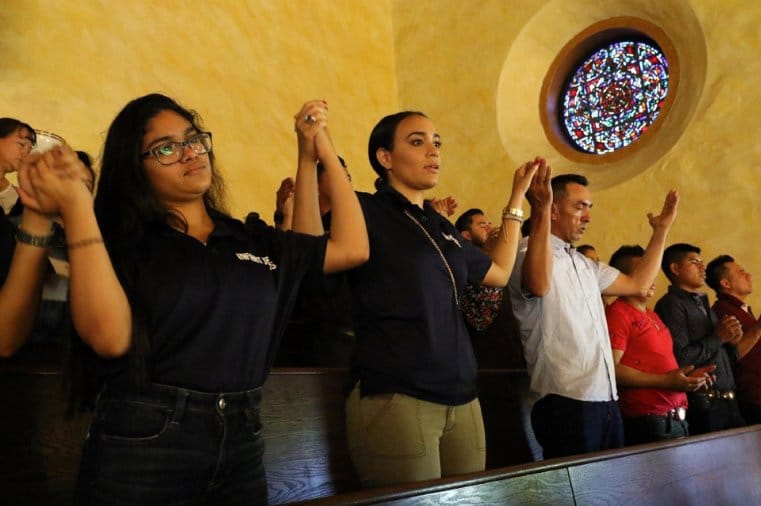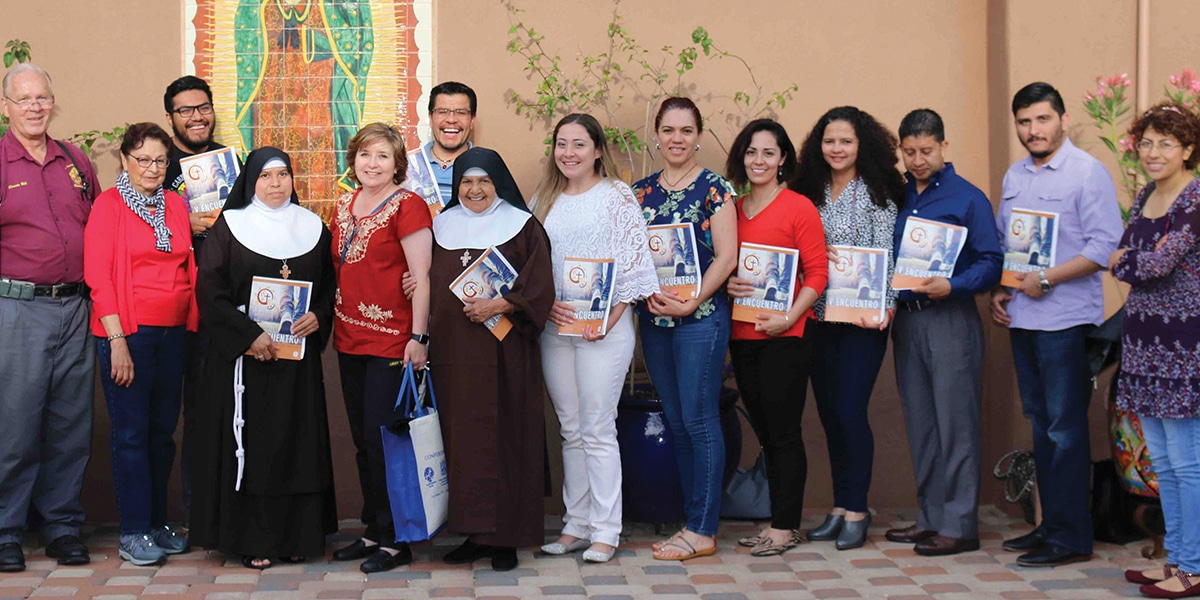The V Encuentro process aims to reawaken the faith and gifts of Hispanic Catholics in the United States.
Julio Beltran knows something about divine providence. Five years ago, the Texas ministry leader drove 250 miles with all his belongings to start a job in the Beaumont Diocese, not knowing where he would stay. Unperturbed, he eventually reached a friend who had a room for him.
Now the diocese’s assistant director of Hispanic ministry, Beltran, 35, again faces uncertainty as he advocates for Catholic youth and young adults in a national Hispanic process convened by the US bishops called V Encuentro, September 20-23, 2018. (V signifies the fifth such process since 1972, and encuentro means “encounter.”)
A “dreamer” who came from Mexico with his parents as a teen and now hopes for US citizenship, Beltran doesn’t know if he’ll have the chance to see youth find their place in the Church. He was granted deferred action from deportation under the federal Deferred Action for Childhood Arrivals (DACA) policy and has fewer than two years remaining on his work permit. Without US government action allowing Beltran and other young adults brought to the United States as children to stay in the country, his status is not secure. But he is trusting God.
A New Generation of Hispanic Leaders
Beltran advocates especially for first- and second-generation Hispanic youth as he helps coordinate the V Encuentro process, which is reaching some of the estimated 30 million US Hispanics who identify as Catholic.
“The Latino community is growing in big numbers, and I think we lack a lot of leadership who know how to work with this bicultural reality of the young people,” says Beltran. “I really hope that the bishops and other ecclesial leaders support more formation of leadership and others who know how to work with the young people.”
Inspired by Pope Francis’ apostolic exhortation “Evangelii Gaudium” (“The Joy of the Gospel”), V Encuentro leaders and participants have sought to discern ways the US Church can better respond to the Hispanic presence and to strengthen their own response to the call for new evangelization as missionary disciples.
Convened in 2013, V Encuentro launched a national dialogue among US Hispanic Catholics that began in parishes, lay ecclesial movements, schools and universities, and other Catholic organizations across the country. Following conversations about their needs, aspirations, and roles in the Church, participants continued the dialogue at diocesan and regional gatherings.
This month, 3,000 delegates selected at the earlier meetings, as well as many cardinals, bishops, and priests, will attend the V National Encuentro in Grapevine, Texas. Conclusions and recommendations from the process are being compiled and will be reviewed by the US bishops. Through the process, V Encuentro leaders hope to identify 20,000 new Church leaders to replace lay ecclesial leaders expected to retire in the next 10 years, according to Alejandro Aguilera-Titus,
the V Encuentro national coordinator.
As of June, more than 330,000 Catholics of different ages and backgrounds had participated in parish and diocesan programs across the country. As part of the process, many have learned techniques for evangelizing family, friends, and neighbors. Some, like Beltran, grapple with immigration issues, but they’ve also expressed the need for a greater sense of community and more faith formation and other programs, especially in Spanish.
Since the last Encuentro process in 2000, more than 20 million Hispanics have immigrated to the United States. According to the Washington-based Center for Applied Research in the Apostolate (CARA), about 70 percent of all Hispanics are Catholic.
“Now we’re coming to the threshold where we’re saying we’ve got so much more and we need to focus and for people to understand the reality of the US Church, the intercultural involvement,” says Deacon Milton Vega, 64, who, with his wife, Elia, 68, lives in St. Johns, Florida.
Hispanic Catholics have made progress, but “there was a need to reawaken with a calling from the pope himself to go and reach out and reawaken the faith in every community,” says Deacon Milton, a V Encuentro participant. “That is one of our goals.”
Welcoming Newcomers
Though the Vegas are both native Spanish speakers, they sometimes struggled to understand each other when they began dating in 1971.
“We were divided by a common language,” says Deacon Milton, whose Puerto Rican Spanish differs from the Spanish that Elia grew up speaking in Peru.
Their situation reveals the challenge immigrants from 23 predominantly Spanish-speaking countries and territories outside the United States can experience in understanding each other, as well as learning English. By welcoming the newcomers and bridging the communication barrier, parishes can encourage them to become involved, Deacon Milton says. “If we are going to successfully integrate as a nation, we have to begin at home in the Church,” he says.
The Vegas meet Hispanics from many places in their work as catechists in their parish, Most Holy Redeemer in Jacksonville, Florida, and as they travel through the St. Augustine Diocese. They see a great need for faith formation, especially in Spanish. “We go out to the peripheries as the pope says and go and teach and spread the Gospel out there and try to help with the formation of newcomers to the faith,” he says.
Says Elia: “There are many, many adults who need to get their sacraments. Either the three Sacraments of Initiation or two of them; some were baptized but never got Confirmation and Communion.”
The Vegas themselves returned to the faith later in life. After experiencing conversions on a 2002 retreat, they’ve gradually become more involved in ministry in their parish and diocese. They have two grown sons. As V Encuentro leaders, they’ve talked with other Hispanic Catholics on the parish, diocesan, and regional levels about the need for formation and the Church’s role in intercultural involvement.
“We can be an outreach to the folks who are now coming into our nation who are members of the Catholic Church,” Deacon Milton says.
Hispanic Catholics of all ages are seeking the Rite of Christian Initiation of Adults (RCIA) and faith formation, but many parishes lack Spanish-language RCIA and formation materials, he says.
“What is happening is separated brethren [Protestant congregations] are providing the facilities for them to go to,” he says. “They’re giving them the books.”
Reaching Out to Youth and Young Adults
Juan Andres Villa, 21, knows about Hispanic Catholics leaving the Church to join Protestant denominations. Two of his sisters became members of nondenominational churches when they were in their mid-20s. Had his sisters known about the Encuentro process when they were younger, they might have remained Catholic, says Villa, who lives in San Bernardino, California.
Villa fell in love with the Catholic faith as a teen in the high school youth group his mother started five years ago at their parish, Our Lady of Guadalupe. He now helps lead the group, which is active in faith and social justice. As an Encuentro participant, he wants to represent the concerns of youth who can’t directly participate because they are minors. In some parishes, youth have struggled to get support and resources to start youth ministry.
“The Church hasn’t been supportive of young people and hasn’t taken time to understand we have a hope that’s awesome,” he says. “One of the things the Church struggles with is pushing down funnels to local parishes. The Church has goals, [but] Pope Francis’ message has to get translated down to have this conversation.”
Villa attends college and works as a youth minister and community activist. He has been part of V Encuentro planning in his diocese for the past three years and hopes to become one of the V National Encuentro delegates. “In the Encuentro process, what I love so much about it is not [only] doing work inside the walls of the church, [but] also being involved in community,” he says.
Young adults are ready to become Church leaders, but it would help if the Church understood young adult culture, he says.
Villa says V Encuentro participants learn from listening to each other. “The most important part is making change, a direct change to the way the Catholic Church in the United States is going to be,” he says. “The process makes you excited about being a Catholic.”

Beltran enjoys seeing how the Gospel transforms young people. But he feels the needs of many young bilingual/bicultural Catholics are being overlooked in the Church. “The young people are bicultural, and I think that in some ways we haven’t appreciated, respected, or promoted these bicultural gifts that they bring,” he says.
He cites a statistic that 73 percent of Catholic young people under 18 in Texas are Hispanics, adding that they could be better represented in Church leadership.
“In the main culture, the message they hear is that they’re not American enough, and, within the Hispanic pastoral juvenil [youth and young adult ministry], they receive the message that they’re not Hispanic enough,” Beltran says, adding that the two cultures could be better integrated.
“I think it’s really a fundamental part to educate, to guide the young people because they are the present and will be the future,” he says, acknowledging that fewer young people are participating in V Encuentro than hoped. “I really believe these young people can bring a lot of gifts to the Church and all society.”
More ministries specifically for youth and young adults can help them use those gifts, he says. “They want a space where they can be active in the community, have their own sense of community, and express themselves without feeling judged or criticized.”
Finding Joy in Sharing the Faith
Lisseth and Maria Garcia reach out to the Hispanic community through their online Christian radio station. From their home in Peoria, Illinois, the mother and daughter broadcast Spanish-language Christian music, Scripture, and other spiritual messages. But they also evangelize in person through their parish, other ministries, and the V Encuentro process.
Lisseth, 42, attributes her faith to lessons her grandfather taught her while she was growing up in Guatemala. “He said, ‘Wherever you go, whatever you say, whatever you do, God is with you.'”
Last year, Lisseth and Maria, 14, along with others from their parish, St. Mary Immaculate in Plainfield, Illinois, participated in a V Encuentro small group. After praying and studying Pope Francis’ teaching on evangelization, the Garcias and friends brought the Gospel message into their neighborhood, local stores, and a hospital.
“It’s an amazing experience to go away from the church because inside the church we learn, but outside the church we need to put the message in the hearts because a lot of people have a lot of problems,” says Lisseth, who teaches Spanish at a Catholic grade school.
Following their success, Lisseth, Maria, and their friends taught a larger parish group about evangelization and led a discussion where parishioners identified the need for a Spanish-language youth group, a Bible study, and possibilities for further online study about the Catholic faith. The pastor has begun to respond to the requests, Lisseth says. “If we learn, we have something to give the community,” she says.
Maria also has seen opportunities for Hispanic youth through V Encuentro. “I think we teens should be more involved in the Church because we’re the future, and . . . what we bring to the future is what the next generations are going to have,” she says. “We want the faith in people to grow so they know more about God and so they can put all their faith in him and they won’t be depressed.”
With her hope that V Encuentro will benefit the US Hispanic Catholic community, Lisseth prays for an increase of faith in the Church and in the desire to serve others. “Now‚ after the V Encuentro‚ we open our ears, mouths, and hearts, and go move to find where you can do something for someone,” she says.
A Brief History of the Encuentro: Hispanic Catholics Find Their Voice
For the past 46 years, the National Encuentro processes have given US Hispanic Catholics opportunities to come together to discern how they respond as Church. During that time, their voices have grown more clear and resonant in an increasingly diverse US Church.
Quoted on the V Encuentro website (VEncuentro.org), Detroit Auxiliary Bishop Arturo Cepeda stated that previous Encuentros have been the “backbone” during the growth of Hispanic ministry, providing an opportunity to interpret and project into the future Hispanic identity, presence, and contribution to the Church and US society as a whole.
When US bishops convened the first Encuentro in 1972, an estimated 10 million Hispanics lived in the United States, according to a study by the Pew Research Center. The goal of the first Encuentro process was to enable the baptized Catholics in this population to “come out of the shadows” as they expressed their needs, aspirations, and contributions.
Five years later, the second Encuentro went further, as US Hispanic Catholics identified themselves as a diverse community united in faith, history, and language. During this process, they discerned a way of being Church based in the ecclesiology of communion and a preferential option for those who are estranged or living in poverty. Eight years later, at the third Encuentro, Hispanic Catholics articulated a clear direction for the Church’s response to the Hispanic presence and their response as Church. The vision was recorded in the “Plan Pastoral Nacional del Ministerio Hispano” (1987), and in an evangelizing, communal, and missionary model of the Church.
By the fourth Encuentro in 2000, the US Hispanic population had grown to more than 35 million. IV Encuentro was an opportunity for US Hispanic Catholics to share the Encuentro experience with all the cultures and races represented in the US Church. The first national Encuentro of youth ministry in 2006 presented an opportunity to listen to Hispanic youth and discern how to respond to their needs.
During the 18-year gap between the IV Encuentro and the current one, the US Hispanic population grew by almost 20 million. During that time, Church leaders have devoted a great deal of time to assisting new arrivals, according to Encuentro leaders. During the V Encuentro, US Hispanic Catholics have been encouraged to continue their walk as God’s people, raise their voices, and discern pastoral priorities and strategies.








